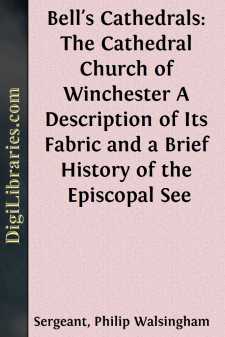Categories
- Antiques & Collectibles 13
- Architecture 36
- Art 48
- Bibles 22
- Biography & Autobiography 813
- Body, Mind & Spirit 142
- Business & Economics 28
- Children's Books 14
- Children's Fiction 11
- Computers 4
- Cooking 94
- Crafts & Hobbies 4
- Drama 346
- Education 46
- Family & Relationships 57
- Fiction 11829
- Games 19
- Gardening 17
- Health & Fitness 34
- History 1377
- House & Home 1
- Humor 147
- Juvenile Fiction 1873
- Juvenile Nonfiction 202
- Language Arts & Disciplines 88
- Law 16
- Literary Collections 686
- Literary Criticism 179
- Mathematics 13
- Medical 41
- Music 40
- Nature 179
- Non-Classifiable 1768
- Performing Arts 7
- Periodicals 1453
- Philosophy 64
- Photography 2
- Poetry 896
- Political Science 203
- Psychology 42
- Reference 154
- Religion 513
- Science 126
- Self-Help 84
- Social Science 81
- Sports & Recreation 34
- Study Aids 3
- Technology & Engineering 59
- Transportation 23
- Travel 463
- True Crime 29
Bell's Cathedrals: The Cathedral Church of Winchester A Description of Its Fabric and a Brief History of the Episcopal See
Categories:
Description:
Excerpt
CHAPTER I
HISTORY OF THE CATHEDRAL
Unlike many of our cathedral cities, "Royal" Winchester has a secular history of the greatest importance, which not only is almost inextricably interwoven with the ecclesiastical annals down to a comparatively recent date, but should at times occupy the foremost position in the records of the place. To attempt, however, to trace the story of the city as well as that of the cathedral would be to recapitulate the most important facts of the history of England during those centuries when Winchester was its capital town. Its civic importance, indeed, was not dependent upon the cathedral alone, for before the introduction of Christianity into the island Winchester was undoubtedly the principal place in the south of England. The Roman occupation, though it seems a mere incident in its record, lasted over three centuries, about as long as from the reign of Henry VIII. to that of Queen Victoria. Richard Warner (1795) sums up the various names of Winchester when he speaks of "the metropolis of the British Belgæ, called by Ptolemy and Antoninus Venta Belgarum; by the Welch or modern Britons, Caer Gwent; and by the old Saxons, Wintancester; by the Latin writers, Wintonia" ("Collections for the History of Hampshire").
Even, therefore, when we read the account of the legendary king of the Britons, Lucius, founding a great church at Winchester in A.D. 164, we do not touch the source of its fame, nor have we discovered the record of the first building devoted to religious worship on the site of the present cathedral. How far certain references to early pagan temples may be trusted does not here concern us; but at Christchurch Priory, some thirty-five miles to the south-west in the same diocese, bones "supposed to be those of sacrificial birds" have been exhumed on the site of its church. There was, however, a relapse into paganism after the first dedication of the Christian building, so that there can be no certainty about the date of such discoveries.
On the authority of Vigilantius' "De Basilica Petri" (i.e. at Wynton or Winchester), quoted by Rudborne in "Anglia Sacra," John of Exeter, and other writers, we have it that a great church was rebuilt from its foundations at Caergwent by Lucius after his conversion in A.D. 164; and that he erected also smaller buildings with an oratory, refectory, and dormitory for the temporary abode of the monks until the monastery itself should be completed. Quotations from another lost author, Moracius, provide us with the dimensions of this edifice, the length being variously given as 209 and 200 passus, the breadth as 80 and 130, while the tower was 92 passus in height. This church, it was said, was dedicated to S. Saviour in November 169, and endowed with property formerly held by the pagan priests. "The site of the monastery to the east of the church was 100 passus in length toward the old temple of Concord and 40 in breadth to the new temple of Apollo. The north position was 160 in length and 98 in breadth. To the west of the church it was 90 in length and 100 in breadth, to the south 405 in length and 580 in breadth." Willis, from whom the above dimensions are quoted, does not attempt to reconcile the figures except in so far as he suggests pedes for passus, substituting one foot for five....


